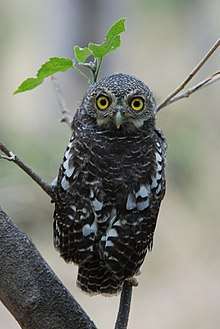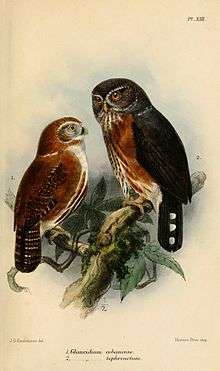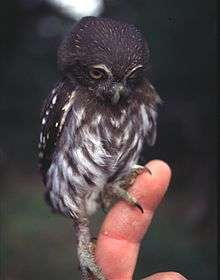Pygmy owl
| Pygmy owls Temporal range: Late Pliocene to Recent | |
|---|---|
 | |
| African barred owlet | |
| Scientific classification | |
| Kingdom: | Animalia |
| Phylum: | Chordata |
| Class: | Aves |
| Order: | Strigiformes |
| Family: | Strigidae |
| Genus: | Glaucidium F. Boie, 1826 |
| Species | |
|
31,[1] see text. | |

Guatemalan pygmy owl (left) and red-chested owlet (right); illustration by Keulemans, 1875

Ferruginos pygmy owl
Pygmy owls are members of the genus Glaucidium. They belong to the typical owl family, Strigidae. The genus consists of about 26 to 35 species distributed worldwide. The exact number of species is somewhat disputed.
These are mostly small owls, and some of the species are called "owlets". Most pygmy owl species are nocturnal and hunt mainly large insects and other small prey.
Glaucidium forms a paraphyletic group with Surnia.[2][3]
Species
- Eurasian pygmy owl (Glaucidium passerinum)
- Collared owlet (Glaucidium brodiei)
- Pearl-spotted owlet (Glaucidium perlatum)
- Northern pygmy owl (Glaucidium californicum)
- Mountain pygmy owl (Glaucidium gnoma)
- Baja pygmy owl (Glaucidium hoskinsii)
- Guatemalan pygmy owl (Glaucidium cobanense)
- Costa Rican pygmy owl (Glaucidium costaricanum)
- Andean pygmy owl (Glaucidium jardinii)
- Cloud-forest pygmy owl (Glaucidium nubicola)
- Yungas pygmy owl, (Glaucidium bolivianum)
- Colima pygmy owl, (Glaucidium palmarum)
- Tamaulipas pygmy owl (Glaucidium sanchezi)
- Pernambuco pygmy owl (Glaucidium mooreorum)
- Central American pygmy owl (Glaucidium griseiceps)
- Subtropical pygmy owl (Glaucidium parkeri)
- Amazonian pygmy owl (Glaucidium hardyi)
- East Brazilian pygmy owl (Glaucidium minutissimum)
- Ferruginous pygmy owl (Glaucidium brasilianum)
- Pacific pygmy owl (Glaucidium peruanum)
- Austral pygmy owl (Glaucidium nana)
- Cuban pygmy owl (Glaucidium siju)
- Red-chested owlet (Glaucidium tephronotum)
- Sjöstedt's barred owlet (Glaucidium sjostedti)
- Asian barred owlet (Glaucidium cuculoides)
- Javan owlet (Glaucidium castanopterum)
- Jungle owlet (Glaucidium radiatum)
- Chestnut-backed owlet (Glaucidium castanotum)
- African barred owlet (Glaucidium capense)
- Albertine owlet (Glaucidium albertinum)
- †Glaucidium kurochkini
The supposed prehistoric species "Glaucidium" dickinsoni is now recognized as a burrowing owl, probably a paleosubspecies providentiae. Bones of an indeterminate Glaucidium have been recovered from Late Pliocene deposits in Poland (Mlíkovský 2002).
References
- ↑ Gill, Frank; Donsker, David, eds. (2017). "Owls". World Bird List Version 7.3. International Ornithologists' Union. Retrieved 10 October 2017.
- ↑ Nieuwenhuyse Dv, Génot J-C, Johnson DH. 2008. The little owl : Conservation, ecology, and behavior of Athene noctua. Cambridge, UK; New York: Cambridge University Press.
- ↑ Wink M, El-Sayed AA, Sauer-Gurth H, Gonzalez J. 2009. Molecular phylogeny of owls (Strigiformes) inferred from DNA sequences of the mitochondrial cytochrome b and the nuclear rag-1 gene. Ardea 97(4):581-591.
- Mlíkovský, Jirí (2002): Cenozoic Birds of the World, Part 1: Europe: 215. Ninox Press, Prague. ISBN 80-901105-3-8 PDF fulltext
External links
| Wikispecies has information related to Glaucidium |
| Wikimedia Commons has media related to Glaucidium. |
- Pygmy owl information
- Mountain Pygmy Owl
- Mountain Pygmy Owl "eyes in back of head"
- Ferruginous pygmy owl
- Colima pygmy owl
- Eurasian pygmy owl
- "Big fight over tiny owl" - CNN/AP article on pygmy owl's endangered species status in Arizona
- ' Pygmy Owls - documentary produced by Oregon Field Guide
- The Neblina Pygmy owl - 2018 BBC internet article on new species found in the Pico da Neblina National Park, Brazil
This article is issued from
Wikipedia.
The text is licensed under Creative Commons - Attribution - Sharealike.
Additional terms may apply for the media files.